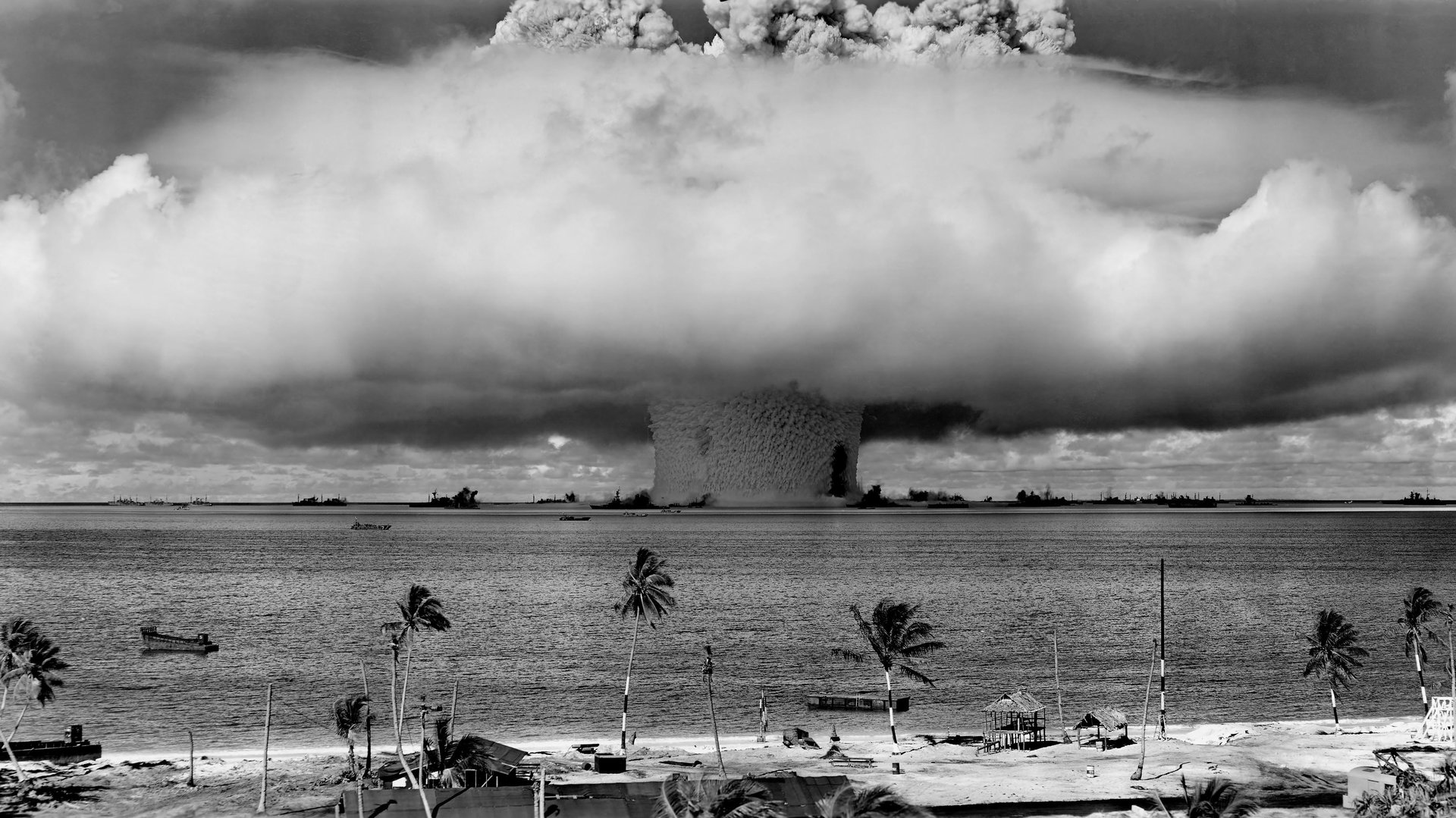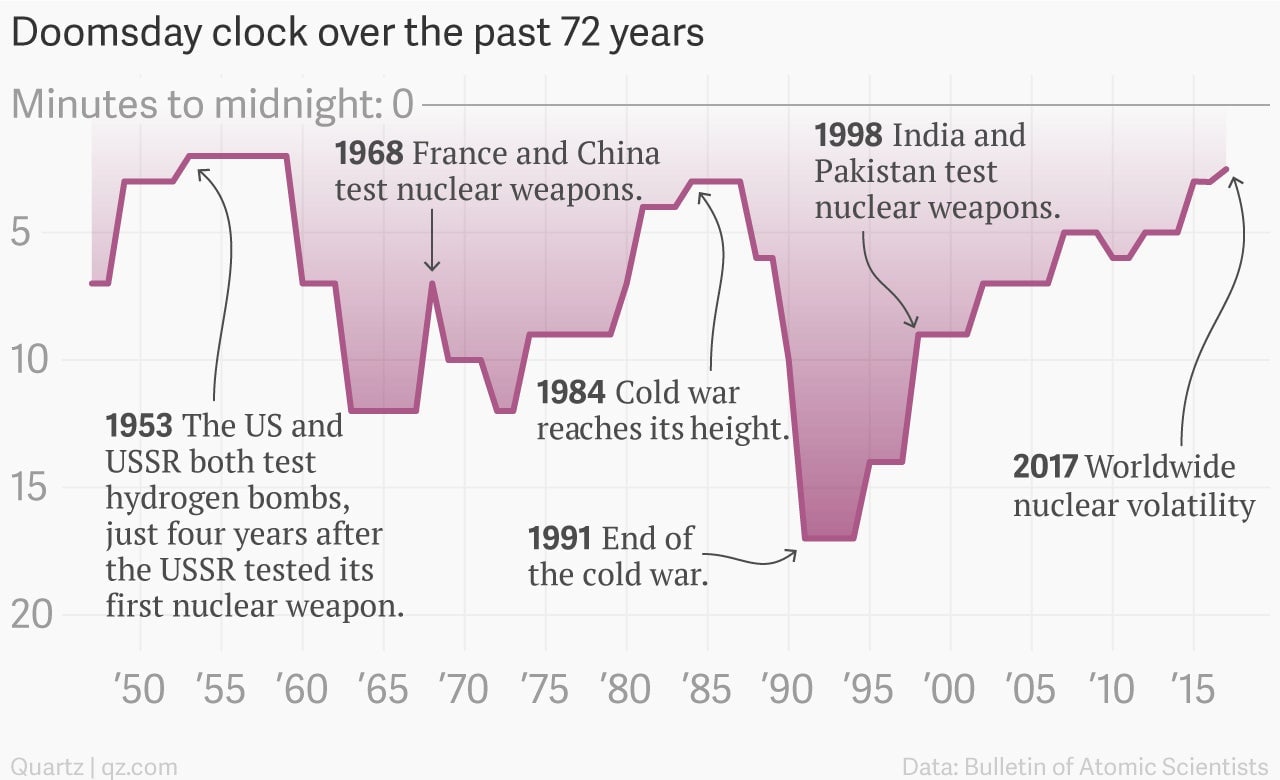Scientists think we’re closer to self-destruction than we have been since the 1950s
This is an article from 2017. Read our most recent coverage of the Doomsday Clock: In 2022, the Doomsday Clock didn’t change for the second year running


This is an article from 2017. Read our most recent coverage of the Doomsday Clock: In 2022, the Doomsday Clock didn’t change for the second year running
In case you didn’t already have enough to worry about.
The Bulletin of Atomic Scientists’ editors convened today to announce that it will be moving the hand on its “Doomsday Clock” thirty seconds closer to midnight, from three minutes to midnight to two-and-a-half minutes to midnight.
This item is about the 2017 update to the Doomsday Clock. In 2021, the Doomsday Clock remained at 100 seconds to midnight.
The election of US president Donald Trump, his belief that climate change is a hoax, and his apparent desire to have a new arms race with Russia, weighed heavily on the group behind the Bulletin as they decided to move the clock’s hand. It’s the first time that the clock has been moved just half a minute. Other moves have been a full minute closer or further from midnight.
“Make no mistake, this has been a difficult year,” the Bulletin’s executive director and publisher Rachel Bronson told the group of assembled journalists at the National Press Club in Washington, DC today. “The cavalier and reckless language around nuclear weapons” from around the world, especially in US during the election, troubled the group of scientists, Bronson added. New nuclear activity in North Korea, Pakistan, India and Russia, along with Trump’s comments about renewing the nuclear arsenal of the US also influenced the Bulletin’s decision to move the clock.

Global warming has also been a large concern for the Bulletin this year. ”Climate change should not be a partisan issue,” said David Titley, Bulletin member, and meteorology and a international affairs professor at Pennsylvania State University. “The planet will continue to warm so long as carbon dioxide is pumped into the atmosphere, irrespective of politics. Trump needs to recognize climate change,” Titley added, “there are no alternative facts here.”
Although Titley admitted that the ratification of the Paris climate treaty and the flat global emissions levels between 2015 and 2016 are positive signs, the fact that 2016 was the warmest year on record for the 16th time in the last 17 years made Titley less optimistic about the world’s prospects.
The Bulletin group also considered the impact of cybersecurity and its impact on the “fabric of democracy” in 2016. For the first time, the proliferation of fake news, the apparent email hacks by foreign entities to undermine democratic elections, and sophisticated hacking attempts on infrastructure systems, all influenced the Bulletin’s decision to move the clock forward.
The group was also concerned about the potential of military systems to rely on “autonomous intelligent systems” that may allow artificially intelligent machines to control nuclear weapons as well as the ability of gene-editing technology like CRSIPR to edit the genes of humans. But these two potential threats were less immediate than those of global warming and nuclear arms. The group said that Trump and Russian president Vladimir Putin “act as petulant children risking our future.”
The Doomsday Clock was developed by a group of academics—including the father of the nuclear bomb, Robert Oppenheimer—that came together in 1945 to highlight the dangers of nuclear weapons and their ability to eradicate the human race. In recent years, the group has considered other existential threats to humanity’s very existence, such as climate change.
The clock, which was set to seven minutes to midnight in 1947, has become a symbolic gesture that the group undertakes each year to stress how close we are to total annihilation. The clock has moved closer and further from its original setting over the years, with the furthest from midnight being 1991, after the fall of the Berlin Wall, the dissolution of the Soviet Union, and a nuclear-arms reduction pact between the US and Russia. The closest to midnight, before this year, was 1959, during the height of the US-Soviet nuclear missile tests, when the clock was set to two minutes to midnight.
“The Doomsday Clock is closer to midnight than it has been in the life of almost everyone in this room,” Lawrence Krauss, a professor in Arizona State University’s School of Earth and Space Exploration and physics department, told the crowd.
“Facts are stubborn things, and they must be taken into account if the future of humanity is to be preserved,” Krauss added.